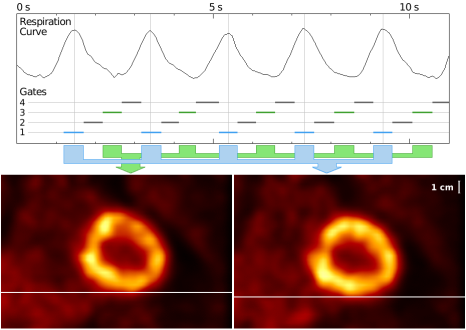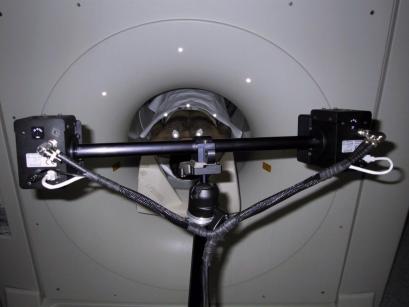Respiratory Motion Estimation: Tests and Comparison of Different Sensors
Physics IDP together with the Nuclear Medicine Department, Klinikum Rechts der Isar der TU München. Though not mentioned in the title, the project had a strong affiliation to PET imaging. A rather detailed overview of the physics of PET is given in the introduction of the report. It can be suggested as reading for other people starting to work in the context of PET.Summary

The principles of respiratory gating.

Clinical setup of the camera system for respiration measurements.
Files
Here is the report of the IDP Respiratory Motion Estimation - Tests and Comparison of Different Sensors as PDF (4.8 MB). The TeX sources can be found in the SVN repository. The Presentation slides for this IDP were created with OpenOffice and are available in OpenDocument Format: Respiratory Motion Estimation - Tests and Comparison of Different Sensors.odp. Since certain popular comercial products don't support this standard yet, here is the same version in MS Power Point format: Respiratory Motion Estimation - Tests and Comparison of Different Sensors.ppt. (However, the latter one is not supposed to look good. Try to use the first one, if possible!) The two small software packages created in this IDP are written in IDL 6.0 under Linux, but should work under Windows, too. ARTCamera.zip contains a software library for processing raw ART camera data in the context of respiratory motion estimation. SignalAnalysis.zip contains a GUI application for extracting respiratory signals from ART camera data, and from other respiration sensors. It also supports comparison of different respiratory signals.| ProjectForm | |
|---|---|
| Title: | Respiratory Motion Estimation |
| Abstract: | Respiratory motion has a big impact on medical imaging of the thorax area and needs to be studied and corrected. Different sensors are clinically available to noninvasively measure the respiratory state of the patient, including an infrared camera system, a pressure detector, a spirometer and a temperature probe. Each sensor uses different physical properties and measures respiratory signals which need to be correlated to the internal organ motion. The goal is to evaluate and compare the different sensors. Experimental measures will be done on volunteers and signal & image processing techniques will be used to analyze the data. The results will then be applied and evaluated for clinical studies. If this goal is achieved on time, the feasibility of a more general patient motion correction using the infrared camera system will be studied. |
| Student: | Michael Riedel |
| Director: | Peter Böni |
| Supervisor: | Nassir Navab, Axel Martinez-Möller, Ralph Bundschuh |
| Type: | IDP |
| Status: | finished |
| Start: | 2005/07/18 |
| Finish: | 2006/04/12 |